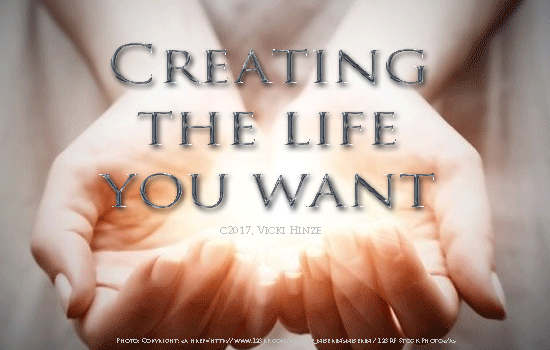CREATING THE LIFE YOU WANT
By
Vicki Hinze

It is typical to start a new year with a clean slate and a fresh attitude. We mentally turn the page on what was, and focus on the potential of what can be. But how do we do that—in practical terms—so that our resolve doesn’t fade after the first three days to a week? So that at the end of the new year we have bettered our life the entire year?
For years, I’ve been an advocate of sitting down and doing a solid self-assessment. Asking myself the hard questions like, What did I actually do with the last year? Is any of it what I said I wanted to do? What didn’t get done, and is it still important to me? If so, how important?
That’s when a priority list comes in. If you assign a priority to every item on your list of what you want, putting what you want most first, then focus on working your way down the list, at the year’s end, you will have accomplished more of what you most want. But prioritizing alone isn’t enough. Why?
Because we’re complex people and our wants are scattered. We have personal and professional wants and needs, goals for ourselves and our families, volunteer project goals, educational goals, and spiritual goals. In each area of our lives, we have priority goals. They’re coming out of our ears. And we have tried the singular focus on one area at a time and that hasn’t worked because we discover wants and needs comingle and we must work multiple fronts simultaneously. When we don’t, we’re not balanced.
We require balance in our lives. It’s as essential to us as drawing breath, and working a single option and then another consecutively just doesn’t work. Important needs or wants simply go unmet. So that rules out a singular-focus goal approach. We accept from the start, or learn to accept, that we don’t just want our goals scattered across different areas of our lives, we need them.
That fact makes it imperative that we recognize and accept our needs and address them. For example, we have multiple areas of needs. Let’s say our Personal goal is to get into better shape. That isn’t going to happen if we don’t make it happen. So we resolve to eat better, get more sleep, and to take half an hour a day to work on fitness. We might walk or swim or play ball in the backyard with the kids. But that thirty minutes each day, we devote to some physical activity to help get us into better shape.
A special word about this because it’s important. Most people don’t get enough rest. That, you might consider a low priority but it isn’t and shouldn’t be. The body heals during rest. The mind clears during rest. Mental pretzels are solved during rest. Paths forward reveal themselves to us when we are rested. Getting decent rest is high priority. We need rest physically, emotionally, and spiritually.
Exhausted people make poor decisions, have more accidents, and are less content. None of that is conducive to achieving goals that bring more of what we want into our lives. So rest. Set a go-to-bed time and stick to it. If you need a powernap midday to function at peak, then schedule one. I take 10-minute powernaps most days. It’s enough. Maybe 10-minute naps work for you or maybe you need 20-minute naps. You best know your body. Listen to it so that it works best for you.
Professionally, you might want to take a course to put you into a better position for a promotion, or to just change your focus. Maybe you’ve taken your job for granted and see now that you should be more dedicated to it. Whatever your goal, it too should have high priority. After all, most of us spend more time working than we do at home. We want and need to be content at work. So we should act deliberately to prioritize what we most want at work.
The thing is, we start out with all these great plans and then life interferes and we lose focus or it’s diverted to whatever grabs our focus. A friend of mine often says, don’t get distracted by the shiny objects.
Shiny objects attack us all and they snag our attention—and steal our focus, if we let them. Then the shine wears off and we’ve lost our momentum on what we most want. It’s a haul to get back into sync with our plan.
Making plans complex can be a problem. I used to do a vision statement where I addressed all the areas of my life and included lists of goals under each aspect. I prioritized those lists and got a lot accomplished. But internally there was a constant war on where to focus. Slivered focus is not the way to balance. I can tell you that from firsthand experience. So I simplified my thinking and then my actions. How?
First, I looked for ways to combine priority items I want to address in different life areas. For example, bringing in Bible study from my Spiritual Enrichment list and incorporating it into my Writing list. In other words, I study (spiritual priority) and then write based on what I’ve studied (writing priority). There’s an undercurrent or an overt Biblical principle in nearly all articles I write. That combination also helped me on the emotional balance sector (emotional balance priority) because balance and inner contentment and peace were running themes in the articles.
Combining these aspects just took a little better planning, specifically looking for ways to multi-task, making sure every action was deliberate and served dual or more purposes. That required a little more thinking. But that thinking time paid huge dividends in my actions. That revealed itself quickly and clearly.
Now I’ve simplified even more. I have an annual word that encapsulates my goals across the board. This year, that word is production. The objective is to accomplish more while working less. Working smarter, not harder. So this year, how I approach things on my list will be from a production perspective. Bible study on what it says about production. Web Work (articles, sites, programs) all looking at what I do through the production lens, seeking more efficient ways of doing things.
Keeping one word uppermost in mind for a set amount of time is a great way to harness focus. It becomes habit and stays with you. You’re training yourself and your thinking to work in harmony with your objectives and goals. This has worked well for me and I hope it will for you, too. If so, great. If not, maybe it’ll lead you to your way that works well for you.
Two other things I want to touch on in this: 1) A tip from the trench and 2) Cull.
- A Tip from the Trench. At the beginning of the year—or today—write yourself a letter. Looking back, recall the high and low points of the last year. Include the “I’m glad I did” and the “I wish I had and hadn’t.” Put the letter away for a week, then re-read it and review your current plan for the year. Ask yourself, if you accomplish everything on your plan, what will your letter to yourself read like next year? You might find yourself adjusting your plan so you have more to be glad about and less to regret. And the best part is you don’t have to step in those same mud-puddles this year. You can revise your plan and avoid them!
- Cull things from your life that do not serve you well. We are pretty good about adding new things to our plans. But when it comes to removing things from it, well, we often struggle with that. It’s as if by removing something we feel we’ve failed in that area. That isn’t true, of course. Well, it might be true, but we need to grasp that failures lead us to eventual successes. What we don’t want to do is to beat dead horses. Doing the same thing year after year and expecting that suddenly this year our efforts will work and produce a different outcome is beating that dead horse. That doesn’t promote success. We have to amend, change, be flexible and alter our methods and even our course. That’s not failing, it’s learning and growing wiser.
Too, we need to remember that we’re not stagnant. We change and what we most want changes. So if something on our list no longer fits us and our aspirations, it shouldn’t be on our list. Its purpose is done. It’s okay to remove things that no longer fit our lives. It’s natural. We don’t drop these things out of a fear of failure or success, we drop them because they no longer serve us well. They are not in harmony with what we most want in the lives we are creating. We evolve, what we want evolves and culling our priorities to reflect that is success. We’re taking an active role to get closer to where we want to be.
Lastly, we all start out the year—any day can be the first day on a personal plan for creating the life you want—with enthusiasm. While useful, unfortunately enthusiasm fizzles pretty quickly. If it has no foundation to support it, we’re pretty much done after that first blush fades.
But if we use self-discipline as enthusiasm’s foundation—if we’re determined to stick with it—then the sky’s the limit. Remember what is at stake here. Remember and reread your letter to yourself. Remember that what you put into your life is what you’ll get out of it. If you want more of what you want in your life, then you have to create that more. It’s not something someone else can do for you. They might try, but they just can’t see your dreams, know your heart, speak to your soul on the same levels you do.
To craft a balanced life with more of what you want and less of what you don’t. That’s your objective. And you alone can best create it. Deliberately and intentionally.
* * * * * * *
 © 2016, Vicki Hinze. Vicki Hinze is the award-winning bestselling author of nearly thirty novels in a variety of genres including, suspense, mystery, thriller, and romantic or faith-affirming thrillers. Her latest release is The Marked Star. She holds a MFA in Creative Writing and a Ph.D. in Philosophy, Theocentric Business and Ethics. Hinze’s website: www.vickihinze.com. Facebook. Books. Twitter. Contact. KNOW IT FIRST! Subscribe to Vicki’s Monthly Newsletter!
© 2016, Vicki Hinze. Vicki Hinze is the award-winning bestselling author of nearly thirty novels in a variety of genres including, suspense, mystery, thriller, and romantic or faith-affirming thrillers. Her latest release is The Marked Star. She holds a MFA in Creative Writing and a Ph.D. in Philosophy, Theocentric Business and Ethics. Hinze’s website: www.vickihinze.com. Facebook. Books. Twitter. Contact. KNOW IT FIRST! Subscribe to Vicki’s Monthly Newsletter!





